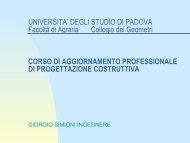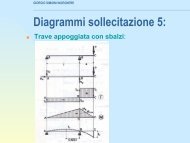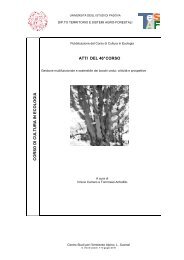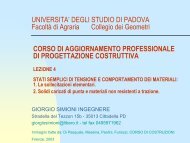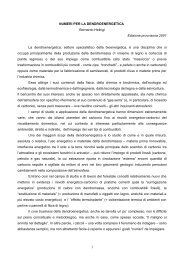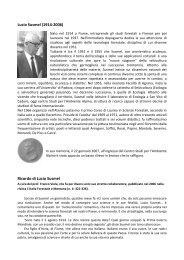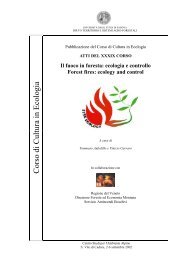humus group - Territorio e Sistemi agro-forestali - Università degli ...
humus group - Territorio e Sistemi agro-forestali - Università degli ...
humus group - Territorio e Sistemi agro-forestali - Università degli ...
Create successful ePaper yourself
Turn your PDF publications into a flip-book with our unique Google optimized e-Paper software.
OF<br />
Figure 3<br />
zo<br />
% volume<br />
roots excluded<br />
90<br />
10<br />
noz<br />
OFzo : zoogenic transformed material ><br />
10 % of the volume of the horizon after<br />
removing living roots.<br />
OFnoz : non zoogenic transformed<br />
material >= 90 % of the volume of the<br />
horizon after removing living roots.<br />
ZOOGENIC TRANSFORMED MATERIAL = RECOGNIZABLE<br />
REMAINS AND HUMIC COMPONENTS processed by animals<br />
= leaves, needles and other plant residues more or less degraded<br />
by soil animals, mixed with animal droppings. A fine powdered<br />
and/or grained structure (less than 1 mm) is typical in a terminal<br />
stage of faunal attack in an organic horizon. At this last level of<br />
biotransformation, the substrate (OH horizon) is essentially<br />
comprised of organic animal droppings of varying size (droppings<br />
of epigeic earthworms, macroarthropods such as millipedes,<br />
woodlice and insect larvae, microarthropods such as mites and<br />
springtails and enchytraeids dominate). Within hemorganic<br />
horizons, animal activity leads to different types of A horizons,<br />
depending on the animals’ ability to dig into the mineral soil and<br />
thoroughly mix organic and mineral matter.<br />
NON ZOOGENIC TRANSFORMED MATERIAL = REMAINS AND<br />
HUMIC COMPONENT processed by fungi or other non-faunal<br />
processes = leaves, needles and other plant residues more or<br />
less fragmented and transformed into fibrous matter by fungi.<br />
Recognizable and recent animal droppings are absent or not<br />
detectable by the naked eye in the organic horizons; fungal<br />
hyphae can be recognized as white, brown or yellow strands<br />
permeating the organic or hemorganic substrates; traces of animal<br />
activity (old bite marks, mucus) may sometimes be detectable but<br />
are always marginal. In the last stage of biodegradation of an<br />
organic horizon, non zoogenic substance may essentially be<br />
composed of brown, dry plant residues more or less in powder<br />
form or tiny fragments (OF and OH horizons), or be massive like a<br />
dark wet plastic clay (OH or very organic A horizons).



